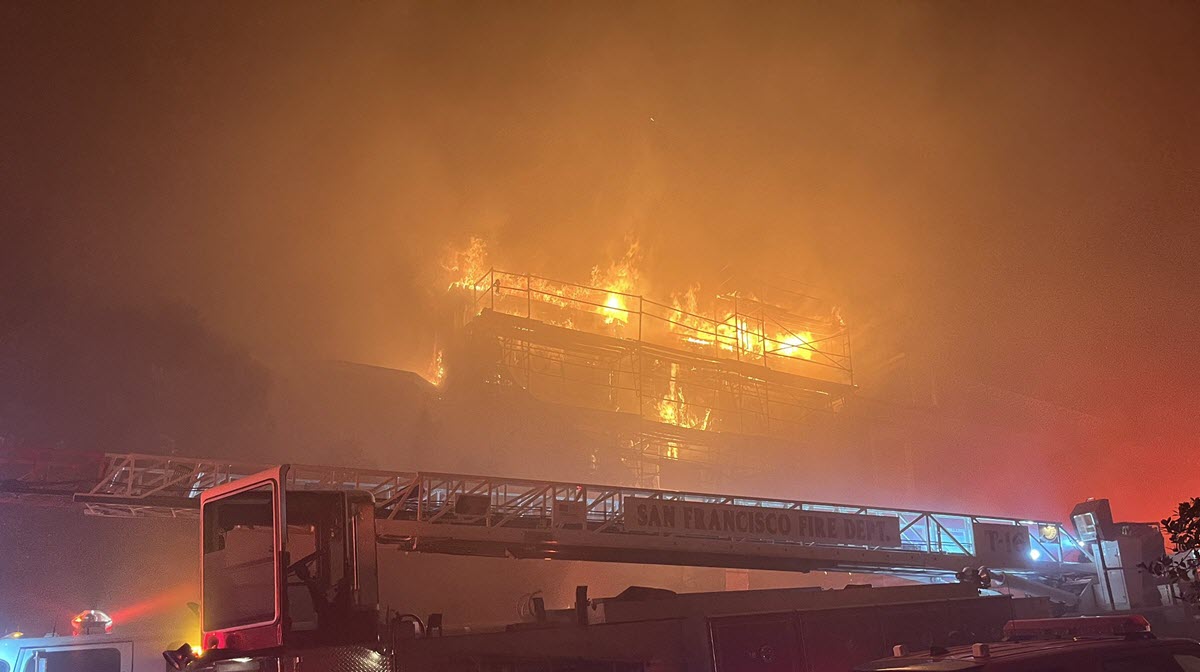A Bay Area quartet loaded a Toyota 4-Runner with nearly $3,000 worth of gear, drove halfway across the country and landed at the Standing Rock Native American Reservation on Thanksgiving not knowing what to expect.
That is until they arrived at the gates of Oceti Sakowin, a self-described peace camp located at the epicenter of the ongoing Dakota Access oil pipeline feud.
"We were welcomed warmly," Joe Finkel of San Francisco said. "The only question at the gate was if we had proper cold weather gear."
That they did. The Bay Area team, which consisted of Finkel and fellow San Franciscan Eric Ruud along with Oakland dwellers Kelsi Seid and Geri Keh, gathered cold-weather supplies such as wool blankets, Arctic-grade ski gloves and solar lanterns before journeying roughly 1,600 miles to hand-deliver the items to those staging a protest against the nearly-finished pipeline, which is currently in a holding pattern courtesy of a court directive. It was the group's way of speaking out against the hotly-contested pipeline.

At the heart of the battle, the argument is this: Native American tribes believe that the 1,200-mile-long pipeline will infringe upon clean drinking water supplies and cultural sites. Energy Transfer Partners, the pipeline’s developer, has countered those claims. They say the pipeline, which will run from the Dakotas to Illinois, is safe and protections will be put in place to combat any potential leaks.
While the bitter dispute rages on, the Bay Area troop wanted to understand the ongoing struggle for themselves. With open minds, they nestled into the protest’s hotbed and soaked in as much as they could in a two-day period.
Local
"I had heard that the prayer camp was peaceful and organized, but I was particularly struck by the level of coordination and hard work going on every waking hour to prepare the prayer camp for winter, even among those who had just arrived the day before," Ruud said. "We saw reinforced winter housing go up in the span of hours, meals for thousands being prepared in multiple kitchens across the camp, and much more."
Various tents within the camp are tasked with, among other things, orienting arriving protesters about the history of the land and its people via film, spreading the movement’s updates on social media, or providing medical assistance to those braving near-freezing temperatures. Not to be overshadowed, but those tents pale in comparison to a prayer circle, the camp’s central hub.
With an open mic at their disposal, tribal elders frequent the circle, which is highlighted by a small fire, and use the stage to chant prayer songs or voice their opinions about the value of what they’re primarily fighting to protect: water.
"The message many of (the tribal elders) had for us was that this wasn't just about their land and their water," Finkel said. "This was about protecting water for all of us."
Making that message a reality rests in halting the construction of the pipeline entirely, protest leaders told the Bay Area crew.
In order to accomplish that goal, those leading the way at Oceti Sakowin promote non-violence.
"Most people at the camp are not actively engaging in the front lines of the protest," Finkel said. "The purpose of the camp is to engage in peaceful prayer."
Despite the peaceful intent, the fight has been marred by physical struggle in recent weeks. Police have used rubber bullets and freezing water to subdue protesters, who they say have been "aggressive" during midnight brawls.
Seid, who was shown video footage of law enforcement personnel pepper-spraying people while they were praying, was stunned by the protesters’ commitment to unshakable resilience.
"Even when faced with militarized aggression from the police, the movement is rooted in prayer," she said.
Ruud was also taken aback to find those at Oceti Sakowin brewing some sympathy for those they are clashing against.
"They are also mournful for the uniformed men and women on the other side of the river who felt locked into the path they are on," he said.
As the tension churns, strong and, at times, roller coaster like emotions continue to flood those speaking out against the pipeline.
"I would describe the mood within the camp as resolute and hopeful, drawing power from unity, but at times very mournful for the sacred land that has already been destroyed, mournful for the violence and destruction being carried out," Ruud said.

Protesters are now faced with combatting the latest development in the ongoing tilt: possible removal. The U.S. Army Corps of Engineers, citing "safety concerns," notified tribes and demonstrators last week that those hunkered down on federal lands north of the Cannonball River, which includes the Oceti Sakowin encampment, will be asked to vacate the area on Dec. 5.
In the announcement, the Corps voiced concern for the impending winter as well ongoing conflict between protesters and law enforcement officials as reasons for penning the decree. Anyone who fails to leave the property could face trespassing charges and subsequent prosecution.
Those heading the protest vow to stay put, but the thought of eviction still makes Finkel uneasy.
"We’re incredibly concerned for the well-being of the thousands of peaceful people we saw there, elders and women and children," he said "They're prepared for the winter and have an outpouring of support from across the country, but a forced evacuation of the camp is awful to contemplate."
Only time will tell what transpires next Monday. After that date, the next decision regarding the pipeline’s construction status is not expected to be handed down by a judge until January at the earliest.
EDITOR'S NOTE: Seid originally stated that "Seeing people praying while being pepper-sprayed by police was heartbreaking, confusing and powerful," but she later clarified and said that "Seeing video footage of people praying while being pepper-sprayed by police was heartbreaking, confusing and powerful."



